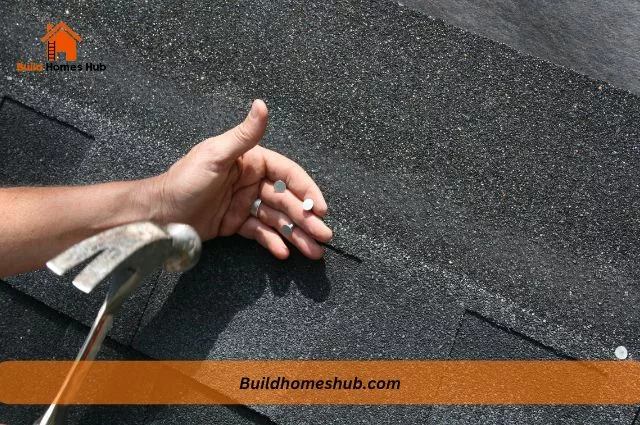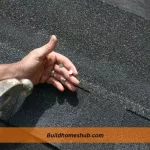When it comes to securing roofing shingles, there are two main methods: hammering and stapling. Each method has its own advantages and disadvantages, and the right choice depends on the roofer’s specific job requirements and preferences. In this article, we will take a closer look at the pros and cons of hammering and stapling, so you can decide which method is right for your next roofing project. We’ll also answer the question: is hammering or stapling better for roofing shingles?
Nailing Roof Shingles
Nailing roof shingles is the traditional method of installation. This involves using roofing nails to secure the shingles to the deck of the roof. The nails are driven through the top of the shingle and into the deck to provide a secure hold. This method is widely used due to its ease of use and accessibility to the necessary tools.
Pros of Nailing Roof Shingles
1. Widely Used
Nailing is the traditional method of installation for roof shingles and as such, is widely used and well-known in the roofing industry. This means finding roofing contractors experienced in nailing is relatively easy.
2. Easy to Install
Nailing shingles is a relatively simple process that most roofing contractors can easily perform. This means that the installation process is often quicker and more efficient when compared to stapling.
Cons of Nailing Roof Shingles
1. Can Cause Damage to the Shingles
When nails are driven through the shingles, there is a risk of cracking or splitting the material. This can weaken the shingles and potentially reduce their lifespan.
2. Nails May Come Loose Over Time
Nails can loosen and come out, leading to the shingles becoming misaligned or falling off altogether. This is especially problematic in areas with high winds or heavy rain.
3. Higher Risk of Water Infiltration
A small opening is left behind when nails are driven through the shingles. Over time, this opening can expand and allow water to penetrate the roof deck. This can lead to leaks and other water-related problems.
Stapling Roof Shingles
Stapling roof shingles is a newer method of installation that involves using roofing staples to secure the shingles to the deck of the roof. The staples are driven through the top of the shingle and into the deck to provide a secure hold. This method is becoming increasingly popular due to its speed and efficiency.
Pros of Stapling Roof Shingles
1. Faster installation time
Stapling roof shingles is a much faster installation method than nailing. This is because the staples can be driven faster and more precisely than nails. This results in a quicker and more efficient installation process, saving time and money in the long run.
2. Reduced risk of damage to shingles
Since staples are driven into the deck of the roof rather than directly into the shingle, there is a reduced risk of damaging the shingle during the installation process. This can result in a longer lifespan for the shingles and a better overall appearance.
3. More secure hold over time
The staples used in stapling roof shingles have a unique design that helps them securely hold in the roof’s deck. This results in a more secure hold over time, reducing the risk of shingle failure or wind damage.
Cons of Stapling Roof Shingles
1. Requires specialized tools
Unlike nailing, stapling roof shingles requires specialized tools that may not be readily available. This can result in a higher cost for the installation process and may limit the number of contractors available to perform the work.
2. Not as widely used or available
Since stapling is a newer installation method, it is less widely used or available than nailing. This can result in limited options for contractors and materials, making it more difficult to find a solution that meets your specific roofing needs.
3. Higher cost
Due to the specialized tools required and the reduced availability of materials and contractors, the cost of stapling roof shingles can be higher than nailing. This may not be a concern for some, but it is important to consider it when deciding.
Is Hammering or Stapling Better for Roofing Shingles?
When it comes down to it, the choice between nailing and stapling for roof shingles will largely depend on personal preference and specific roofing needs. If you are looking for a tried and true method with a low cost and easy availability of tools, nailing may be the way to go. However, stapling may be your better choice if you prioritize speed and long-term durability. Here’s a comparison table.
| Feature | Nailing | Stapling |
| Installation Time | Moderate | Faster |
| Damage to Shingles | Moderate Risk | Low-Risk |
| Security Over Time | Adequate | Improved |
| Tools Required | Standard Nailing Gun | Specialized Staple Gun |
| Availability | Widely Available | Limited Availability |
| Cost | Moderate | Higher |
The Debate between Hand Nailing and Nail Guns
As a roofing professional, you want to ensure the longevity and stability of your work. One of the key components of this is the type of nails used to secure your shingles. The question remains, should roofers use nail guns or hand nail shingles?
The Advantages of Hand Nailing
Hand nailing has been the traditional method of securing shingles for many years. The advantages of hand nailing include:
- Greater control over the depth of the nail, ensuring proper penetration and holding power
- Less damage to the shingle, as hand nailing allows for a softer touch
- Improved accuracy, as you can feel when the nail is properly set
However, hand nailing can be time-consuming and physically demanding. This is where the use of nail guns comes in.
The Advantages of Nail Guns
Nail guns are a more modern method of securing shingles. They offer several benefits, including:
- Speed: Nail guns can fire nails much faster than a person can hand nail
- Efficiency: Nail guns save time and effort, allowing roofers to complete jobs more quickly
- Consistency: Nail guns can fire nails at a consistent depth, reducing the likelihood of shingle damage
Making the Right Choice
When deciding between hand nailing and nail guns, there are several factors to consider. The roofing job type, the roofer’s experience, and personal preferences all play a role in determining the best method.
Hand-nailing may be the best choice for smaller jobs or those who prefer the traditional method. However, nail guns are the way for larger jobs or those looking to increase efficiency.
Conclusion
Both nailing and stapling have pros and cons, and choosing the right option will largely depend on your specific roofing needs. Be sure to consider the factors mentioned in the article and consult with a professional roofing contractor to make the best decision for your roof. Whether you choose to nail or staple your roof shingles, the most important thing is to ensure that the installation is done correctly and with the right tools to ensure long-lasting results.
I like to think I can help you with all the information you need on home renovations and DIY tips. You should subscribe.











